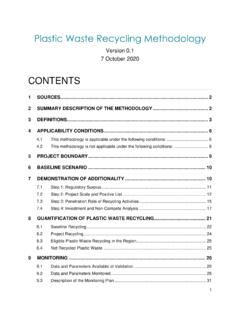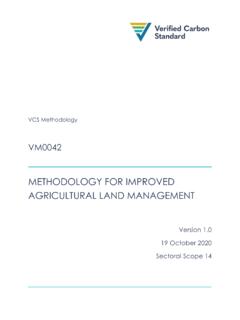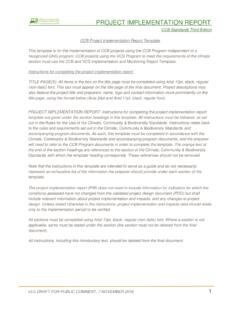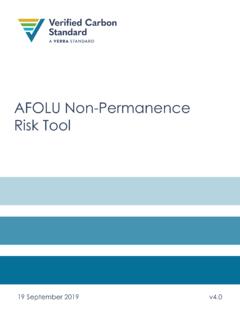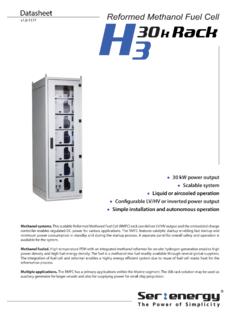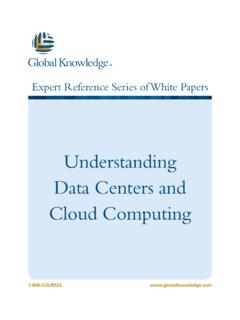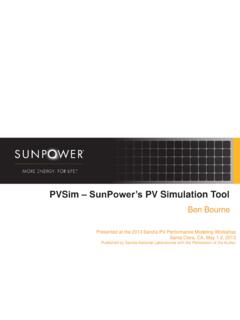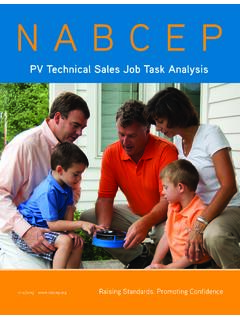Transcription of Estimation of Baseline Carbon Stock Changes and Greenhouse ...
1 MODULE/TOOL: VCS Version 3 1 Estimation of Baseline Carbon Stock Changes and Greenhouse Gas Emissions in Tidal Wetland Restoration and Conservation Project Activities (BL-TW) Title Estimation of Baseline Carbon Stock Changes and Greenhouse gas emissions in tidal wetland restoration and conservation project activities (BL-TW) Version 20170112 Date of Issue 13 January 2017 Type Module Sectoral Scope Sectoral Scope 14 Prepared By University of Maryland, Silvestrum Climate Associates, Restore America s Estuaries Contact Silvestrum Dr. Igino Emmer Dorpsstraat 4, 1546 LJ, Jisp, The Netherlands Email: Tel: +31 653699610 Restore America s Estuaries Mr. Stephen Emmett-Mattox 2020 14th St. North, Suite 210 Arlington, VA 22201, USA Email: Tel: +1 720-300-3139 MODULE/TOOL: VCS Version 3 2 Table of Contents 1 SOURCES 3 2 SUMMARY DESCRIPTION OF THE MODULE 3 3 DEFINITIONS 4 4 APPLICABILITY CONDITIONS 6 5 PROCEDURES 6 General 6 General Procedures 6 Proxy Areas 9 Accounting for Submergence and Erosion 10 Assessing Soil GHG Emissions in the Baseline Scenario 11 General 11 CO2 Emissions from Soil in situ 14 CO2 Emissions from Eroded Soil 19 CO2 Emissions from Soil Exposed to an Aerobic Environment Through Excavation or Drainage 22 CH4 Emissions from Soil in situ 24 N2O Emissions from Soil in situ 26 6 DATA AND PARAMETERS 28 Data and Parameters Available at Validation 28 Data and Parameters Monitored 42 7 REFERENCES AND OTHER INFORMATION 42 MODULE/TOOL.
2 VCS Version 3 3 1 SOURCES This module is one of numerous modules that constitute the VCS approved methodology VM0007: REDD Methodology Modules whose framework document is coded REDD+ MF. This module uses the latest version of the following methodology: VM0033 Methodology for tidal wetland and seagrass restoration This module uses the latest version of the following modules: Module M-TW VMD00xx Methods for monitoring of soil Carbon Stock Changes and Greenhouse gas emissions and removals in tidal wetland restoration and conservation project activities (M-TW) Module CP-AB VMD0001 Estimation of Carbon stocks in the above- and belowground biomass in live tree and non-tree pools Module BL-PL VMD0006 Estimation of Baseline Carbon Stock Changes and Greenhouse gas emissions from planned deforestation and planned degradation Module BL-UP VMD0007 Estimation of Baseline Carbon Stock Changes and Greenhouse gas emissions from unplanned deforestation Module E-FFC VMD0014 Estimation of emissions from fossil fuel combustion Module X-STR VMD0016 Methods for stratification of the project area Module VMD0019 Methods to project future conditions Module BL-ARR VMD0041 Estimation of Baseline Carbon Stock Changes and Greenhouse gas emissions in ARR project activities on peat and mineral soil Module VMD0045 M-ARR Methods for monitoring Greenhouse gas emissions and removals in ARR project activities on peat and mineral soil 2 SUMMARY DESCRIPTION OF THE MODULE This module is for the Estimation of Baseline
3 Emissions associated with WRC project activities implemented on tidal wetlands. This module provides conservative procedures to estimate emission reductions and removals generated by Restoration of Wetland Ecosystems (RWE) and Conservation of Intact Wetlands (CIW) project activities. MODULE/TOOL: VCS Version 3 4 3 DEFINITIONS Allochthonous Soil Organic Carbon Soil organic Carbon originating outside the project area deposited within the project boundary (compare to unreactive allochthonous soil organic Carbon , below) Autochthonous Soil Organic Carbon Soil organic Carbon originating or forming in the project area ( , from vegetation) Carbon Preservation Depositional Environment (CPDE): Type of sub-aquatic sediment deposition environment that impacts the amount of deposited organic Carbon that is preserved. Carbon preservation is affected by mineral grain size, sediment accumulation and burial rates, O2 availability in the overlying water column and sediment hydraulic conductivity.
4 Deltaic Fluidized Mud A Carbon Preservation Depositional Environment (CPDE) type. This subaquatic depositional environment is characterized by sediment accumulation rates generally greater than g per cm2 per year in deltaic settings, consisting primarily of fluidized (unconsolidated) fine-grain materials. Surface sediments may be re-suspended by waves and tides, but deposited organic matter will be buried. Examples of these can be found in the Amazon and Mississippi deltas. Extreme Accumulation Rate A Carbon Preservation Depositional Environment (CPDE) type. This subaquatic depositional environment is characterized by accumulation rates generally greater than 1 g per cm2 per year resulting in rapid and long-term burial of deposited sediments. Examples of these systems can be found in the Ganges-Brahmaputra and Rhone river deltas. Impounded Water A pool of water formed by a dam or pit Mangrove A subset of wetlands dominated by mangrove plant species, which are shrubs or trees that grow in coastal saline or brackish water Marsh A subset of wetlands characterized by emergent soft-stemmed vegetation and shrubs adapted to saturated soil conditions1 Mineral Soil A soil that does not meet the definition of an organic soil Mudflat A subset of tidal wetlands consisting of soft substrate and a near absence of emergent vegetation 1 There are many different kinds of marshes, ranging from the prairie potholes to the Everglades, coastal to inland, freshwater to saltwater, but the scope of this methodology is limited to tidal marshes.
5 Salt marshes consist of salt-tolerant and dwarf brushwood vegetation overlying mineral or organic soils. MODULE/TOOL: VCS Version 3 5 Normal marine A Carbon Preservation Depositional Environment (CPDE) type. This is a depositional environment that does not meet the definition of the other four defined conditions ( , deltaic fluidized mud, extreme accumulation rate, oxygen depletion zone, or small mountainous river). Normal marine environments typically have low sedimentation rates and high O2 availability in overlying sediments. Open Water An area in which water levels do not fall to an elevation that exposes the underlying substrate Organic Soil Soil with a surface layer of material that has a sufficient depth and percentage of organic Carbon to meet an internationally accepted threshold ( , host-country, FAO or IPCC) of organic soil. Where used in this methodology, the term peat is used to refer to organic soil.
6 Oxygen (O2) Depletion Zone A Carbon Preservation Depositional Environment (CPDE) type. This is a depositional environment with low O2 levels in water overlying sediments due to restricted hydrologic circulation or impaired water quality that leads to hypoxic or anaerobic conditions (including euxinic and semi-euxinic). Salinity Average The average water salinity value of a wetland ecosystem used to represent variation in salinity during periods of peak CH4 emissions ( , during the growing season in temperate ecosystems) Salinity Low Point The minimum water salinity value of a wetland ecosystem used to represent variation in salinity during periods of peak CH4 emissions ( , during the growing season in temperate ecosystems) Seagrass Meadow An accumulation of seagrass plants over a mappable area. This definition includes both the biotic community and the geographic area where the biotic community occurs. Note that the vast majority of seagrass meadows are subtidal, but a percentage are intertidal.
7 Small Mountainous River A Carbon Preservation Depositional Environment (CPDE) type. This is a depositional environment from which the sediment is supplied from small mountainous rivers, most commonly found in tectonically active margins and small steep gradients. Sediment accumulation rates are generally greater than g per cm2 per year. Examples of these systems can be found in the rivers flowing from the island of Taiwan and the Eel river of California. Tidal Wetland A subset of wetlands under the influence of the wetting and drying cycles of the tides ( , marshes, seagrass meadows, tidal forested wetlands and mangroves). Subtidal seagrass meadows are not subject to drying cycles, but are still included in this definition. Tidal Wetland Restoration Restoration of degraded tidal wetlands in which establishment of prior ecological conditions is not expected to occur in the absence of the project activity. For the purpose of this methodology, this MODULE/TOOL: VCS Version 3 6 definition also includes activities that create wetland ecological conditions on mudflats or within open or impounded water.
8 Unreactive Allochthonous Soil Organic Carbon The portion of soil organic Carbon originating outside the project area and deposited in the project area that would be stable over the project period regardless of depositional environment. In practice, it is the portion of allochthonous soil organic Carbon associated with and stabilized by soil minerals. Water Table Depth Depth of subsoil or above-soil surface of free water, relative to the soil surface. Acronyms ARR Afforestation, Reforestation and Revegetation REDD Reducing Emissions from Deforestation and forest Degradation RWE Restoration of Wetlands Ecosystems CIW Conservation of Intact Wetlands VCS Verified Carbon Standard WRC Wetlands Restoration and Conservation CPDE Carbon Preservation Depositional Environment GHG Greenhouse Gas SOC Soil Organic Carbon 4 APPLICABILITY CONDITIONS This module applies to tidal wetland restoration and conservation project activities, as defined in REDD+ MF. This module is applicable under the same applicability conditions outlined in REDD+ MF for WRC project activities.
9 5 PROCEDURES General General Procedures Emissions in the Baseline scenario are attributed to Carbon Stock Changes in biomass Carbon pools, soil processes, or a combination of these. In addition, where relevant, emissions from fossil fuel use may be quantified. Emissions in the Baseline scenario are estimated as: GHGBSL-TW = GHGBSL-biomass + GHGBSL-soil + GHGBSL-fuel (1) GHGBSL-biomass=-t=1t* 4412 DCBSL-biomass,i,t i=1 MBSL (2) MODULE/TOOL: VCS Version 3 7 GHGBSL-soil=t=1t* GHGBSL-soil,i,ti=1 MBSL (3) GHGBSL-fuel=t=1t* GHGBSL-fuel,i,ti=1 MBSL (4) Where: GHGBSL-TW Net CO2e emissions in the Baseline scenario up to year t*; t CO2e GHGBSL-biomass Net CO2e emissions from biomass Carbon pools in the Baseline scenario up to year t*; t CO2e GHGBSL-soil Net CO2e emissions from the SOC pool in the Baseline scenario up to year t*; t CO2e GHGBSL-fuel Net CO2e emissions from fossil fuel use in the Baseline scenario up to year t*; t CO2e CBSL-biomass,i,t Net Carbon Stock Changes in biomass Carbon pools in the Baseline scenario in stratum i in year t.
10 T C yr-1 GHGBSL-soil,i,t GHG emissions from the SOC pool in the Baseline scenario in stratum i in year t; t CO2e yr-1 GHGBSL-fuel,i,t GHG emissions from fossil fuel use the Baseline scenario in stratum i in year t; t CO2e yr-1 i 1, 2, 3 ..MBSL strata in the Baseline scenario t 1, 2, 3, .. t* years elapsed since the project start date Estimation of GHG emissions and removals related to the biomass pool is based on Carbon Stock Changes . For ARR project activities on tidal wetlands, procedures are provided in Module BL-ARR. For REDD project activities on tidal wetlands, procedures are provided in Modules CP-AB. When using Modules BL-ARR and CP-AB, note must be taken of procedures provided in Section Estimation of GHG emissions and removals from the SOC pool is based on either various proxies ( , Carbon Stock change, water table depth) or through the use of literature, data, default factors or models. Procedures are provided in this module. Procedures for the Estimation of emissions from fossil fuel use are provided in Module E-FFC.
